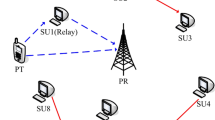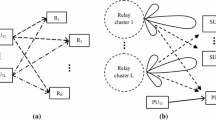Abstract
This paper deals with a joint relay selection and spectrum sensing problem for multi-relay Cognitive Radio Networks. The aim is to determine optimum relays to achieve sufficient performances of both cooperative transmission and spectrum sensing for the secondary network, while ensuring the quality of service of primary user. In the first stage, best relay selection method investigated for cooperative transmission and cooperative spectrum sensing in Cognitive Radio Networks. Thereafter, a multiple relay selection method proposed to improve the performance of the system. This jointly optimized method is capable of selecting “multiple best” relays for transmission as well as spectrum sensing. The proposed method provides cooperative communication and cooperative spectrum sensing performed at the same multiple terminals. As such, individually selected best relays for transmission and for spectrum sensing may be used cooperatively. Simulation results are given to demonstrate that our proposed optimum relay selection method provides beneficial performances for both transmission and spectrum sensing in Cognitive Radio Networks.











Similar content being viewed by others
References
Mitola, J, III., & Maquire, G. Q, Jr. (1999). Cognitive radio: Making software radios more personal. IEEE Personal Communications, 6(4), 13–18.
Haykin, S. (2005). Cognitive radio: Brain-empowered wireless communications. IEEE Journal on Selected Areas in Communications, 23(2), 201–220.
Xing, Y., Mathur, C. N., Haleem, M. A., Chandramouli, R., & Subbalakshmi, K. P. (2007). Dynamic spectrum access with QoS and interference temperature constraints. IEEE Transactions on Mobile Computing, 6(4), 423–433.
Laneman, J. N., Tse, D. N. C., & Wornell, G. W. (2004). Cooperative diversity in wireless networks: Efficient protocols and outage behavior. IEEE Transactions on Information Theory, 50(12), 3062–3080.
Bletsas, A., Khitsi, A., Reed, D. P., & Lippman, A. (2006). A simple cooperative diversity method based on network path selection. IEEE Journal on Selected Areas in Communications, 24(3), 659–672.
Eddaghel, M. M., Mannai, U. N., Chen, G. J., & Chambers, J. A. (2013). Outage probability analysis of an amplify-and-forward cooperative communication system with multi-path channels and max-min relay selection. IET Communications, 7(5), 408–416.
Beres, E., & Adve, R. S. (2006). On selection cooperation in distributed networks. In IEEE conference on information sciences systems.
Tannious, R., & Nosratinia, A. (2008). Spectrally-efficient relay selection with limited feedback. IEEE Journal on Selected Areas in Communications, 26(8), 1419–1428.
Jia, J., Zhang, J., & Zhang, Q. (2009). Cooperative relay for cognitive radio networks. In Proceedings of the IEEE INFOCOM 2009 (pp. 2304–2312).
Chandran, A., Karthik, A., Kumar, A., Naidu, R. C., Siva, M. S., Lyer, U. S., & Ramanathan, R. (2011). Discrete wavelet transform based spectrum sensing in futuristic cognitive radios. In Devices and Communicatios 1–4 (pp. 24–25).
Zhang, S. B., & Qin, J. J. (2010). Energy detection algorithm based on wavelet packet transform under uncertain noise for spectrum sensing. In Wireless Communications Networking and Mobile Computing (pp. 1–4).
Yingpei, L., Chen, H., Lingge, J., & Di, H. (2010). A cyclostationary-based spectrum sensing method using stochastic resonance in cognitive radio. In IEEE Communications Workshops (ICC) (pp. 1–5).
Shen, Juei-Chin, & Alsusa, E. (2013). Joint cycle frequencies and lags utilization in cyclostationary feature spectrum sensing. IEEE Transactions on Signal Processing, 61(21), 5337–5346.
Akyildiz, I. F., Lo, B. F., & Balakrishnan, R. (2011). Cooperative spectrum sensing in cognitive radio networks: A survey. Physical Communication, 4(1), 40–62.
Ganesan, G., & Li, Y. G. (2007). Cooperative spectrum sensing in cognitive radio-part I: Two user networks. IEEE Transactions on Wireless Communications, 6(6), 2204–2213.
Kartlak, H., Bektas, C., Odabasioglu, N., & Akan, A. (2012). An optimum relay selection for cooperative transmission and spectrum sensing in cognitive networks. In 4th International congress on ultra modern telecommunications and control systems and workshops (pp. 969–973).
Kartlak, H., Odabasioglu, N., & Akan, A. (2014). Optimum relay selection for cooperative spectrum sensing and transmission in cognitive networks. In 22nd Signal processing and communications applications conference (SIU 2014) (pp. 1187–1190).
Zou, Y., Zhu, J., Zheng, B., & Yao, Y. (2010). An adaptive cooperation diversity scheme with best-relay selection in cognitive radio networks. IEEE Transactions on Signal Processing, 58(10), 5438–5445.
Kartlak, H., Odabasioglu, N., & Akan, A. (2011). Joint multiple relay selection and power optimization in two-way relay networks. In 3rd International congress on ultra modern telecommunications and control systems and workshops (ICUMT) (pp. 1–4).
Kartlak, H., Odabasioglu, N., & Akan, A. (2012). Adaptive multiple relay selection and power optimization for cognitive radio networks. In International conference on communications, (COMM 2012) (pp. 197–200).
Gardner, W. A. (1986). The spectral correlation theory of cyclostationary time-series. Signal Processing, 11, 13–36. (Elsevier Science Pub.B.V. North-Holland).
Author information
Authors and Affiliations
Corresponding author
Additional information
This work was supported by The Research Fund of Istanbul University. Project numbers: T-16723, 42330 and 45259.
Rights and permissions
About this article
Cite this article
Kartlak, H., Odabasioglu, N. & Akan, A. Cooperation Methods for Cognitive Radio Systems. Wireless Pers Commun 94, 3217–3232 (2017). https://doi.org/10.1007/s11277-016-3773-z
Published:
Issue Date:
DOI: https://doi.org/10.1007/s11277-016-3773-z




